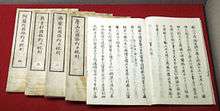Ansei Treaties

Treaties of Amity and Commerce between Japan and the Netherlands, United Kingdom, France, Russia and the United States, 1858.

The Ryōsen-ji Temple in Shimoda, where the US-Japan Treaty of Amity and Commerce, the first of the Ansei Treaties, was signed in July 1858.
Signature of the Franco-Japanese treaty in October 1858 in Edo, the last of the Ansei Treaties to be signed.
The Ansei Treaties (Japanese:安政条約) or the Ansei Five-Power Treaties (Japanese:安政五カ国条約) are a series of treaties signed in 1858, during the Japanese Ansei era, between Japan on the one side, and the United States, United Kingdom, Russia, Netherlands and France on the other.[1] The first treaty, also called the Harris Treaty, was signed by the United States in July 1858, with France, Russia, United Kingdom, and the Netherlands quickly following the US example within the year: Japan was forced to apply to other nations the conditions granted to the United States under the "most favoured nation" provision.
Content
The most important points of these "unequal treaties" are:
- Exchange of diplomatic agents.
- Edo, Kobe, Nagasaki, Niigata, and Yokohama’s opening to foreign trade as ports.
- Ability of foreign citizens to live and trade at will in those ports (only opium trade was prohibited).
- A system of extraterritoriality that provided for the subjugation of foreign residents to the laws of their own consular courts instead of the Japanese legal system.
- Fixed low import-export duties, subject to international control, thus depriving the Japanese government control of foreign trade and protection of national industries (the rate would go as low as 5% in the 1860s.)
Components
The five treaties known collectively as the Ansei Treaties were:
- The Treaty of Amity and Commerce (United States-Japan) on July 29, 1858.
- The Treaty of Amity and Commerce between the Netherlands and Japan on August 18, 1858.
- The Treaty of Amity and Commerce between Russia and Japan on August 19, 1858.
- The Anglo-Japanese Treaty of Amity and Commerce on August 26, 1858.
- The Treaty of Amity and Commerce between France and Japan on October 9, 1858.
See also
Notes
- ↑ Auslin, p.1
References
- Auslin, Michael R. (2004). Negotiating with Imperialism: The Unequal Treaties and the Culture of Japanese Diplomacy. Cambridge: Harvard University Press. ISBN 978-0-674-01521-0; OCLC 56493769
Further reading
- Omoto Keiko, Marcouin Francis (1990) Quand le Japon s'ouvrit au monde (French) Gallimard, Paris, ISBN 2-07-076084-7
- Polak, Christian. (2001). Soie et lumières: L'âge d'or des échanges franco-japonais (des origines aux années 1950). Tokyo: Chambre de Commerce et d'Industrie Française du Japon, Hachette Fujin Gahōsha (アシェット婦人画報社).
- __________. (2002). 絹と光: 知られざる日仏交流100年の歴史 (江戶時代-1950年代) Kinu to hikariō: shirarezaru Nichi-Futsu kōryū 100-nen no rekishi (Edo jidai-1950-nendai). Tokyo: Ashetto Fujin Gahōsha, 2002. ISBN 978-4-573-06210-8; OCLC 50875162
See also
This article is issued from Wikipedia - version of the 10/29/2016. The text is available under the Creative Commons Attribution/Share Alike but additional terms may apply for the media files.